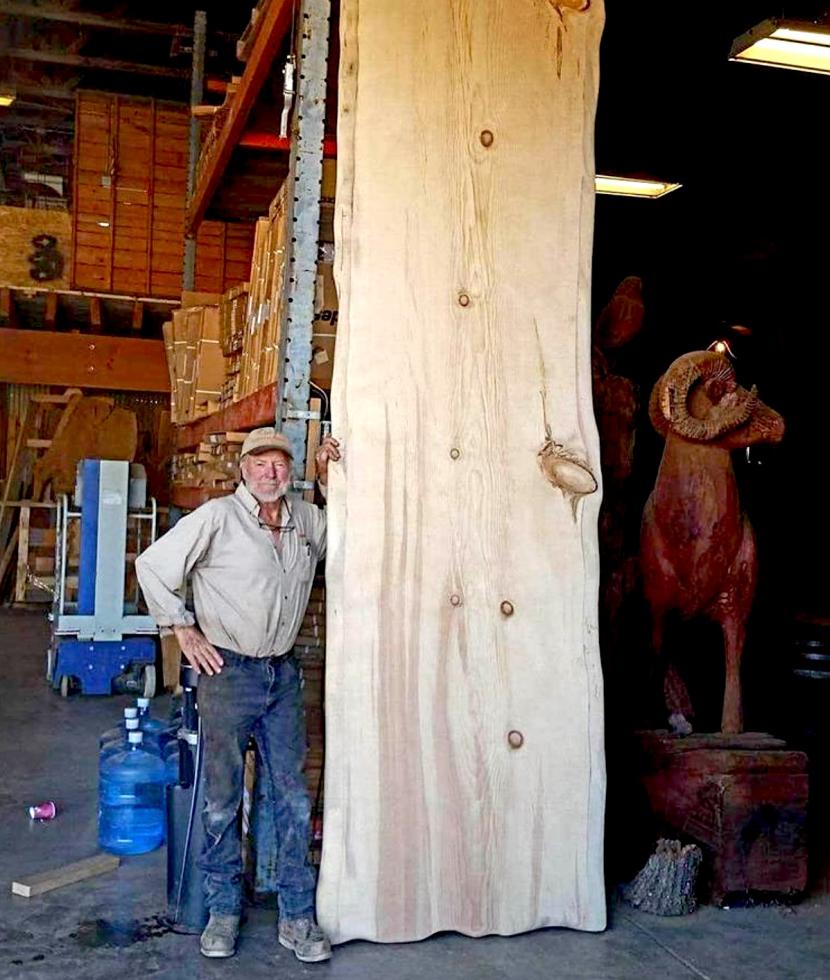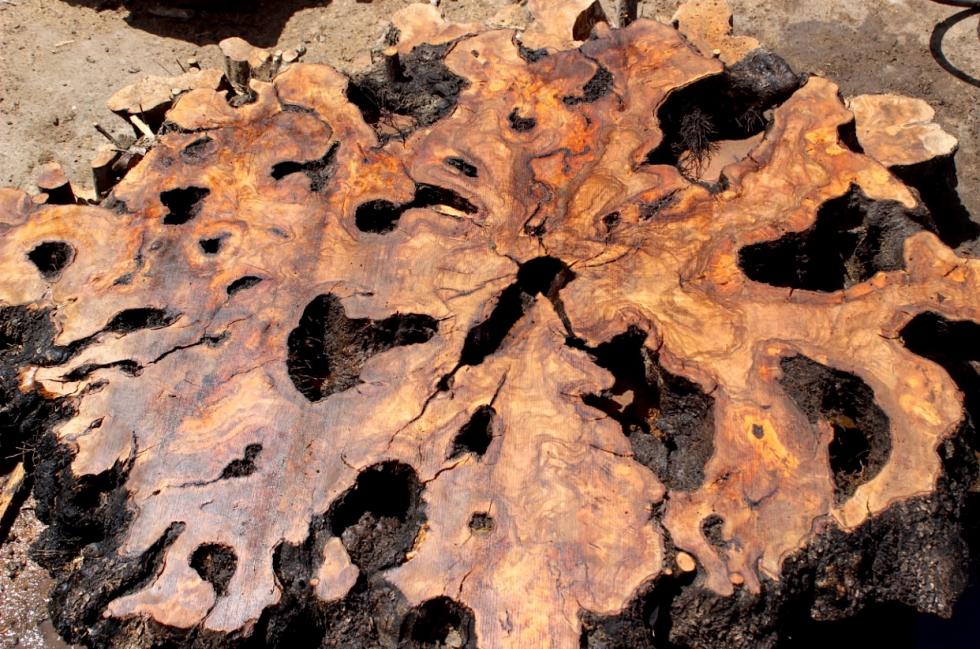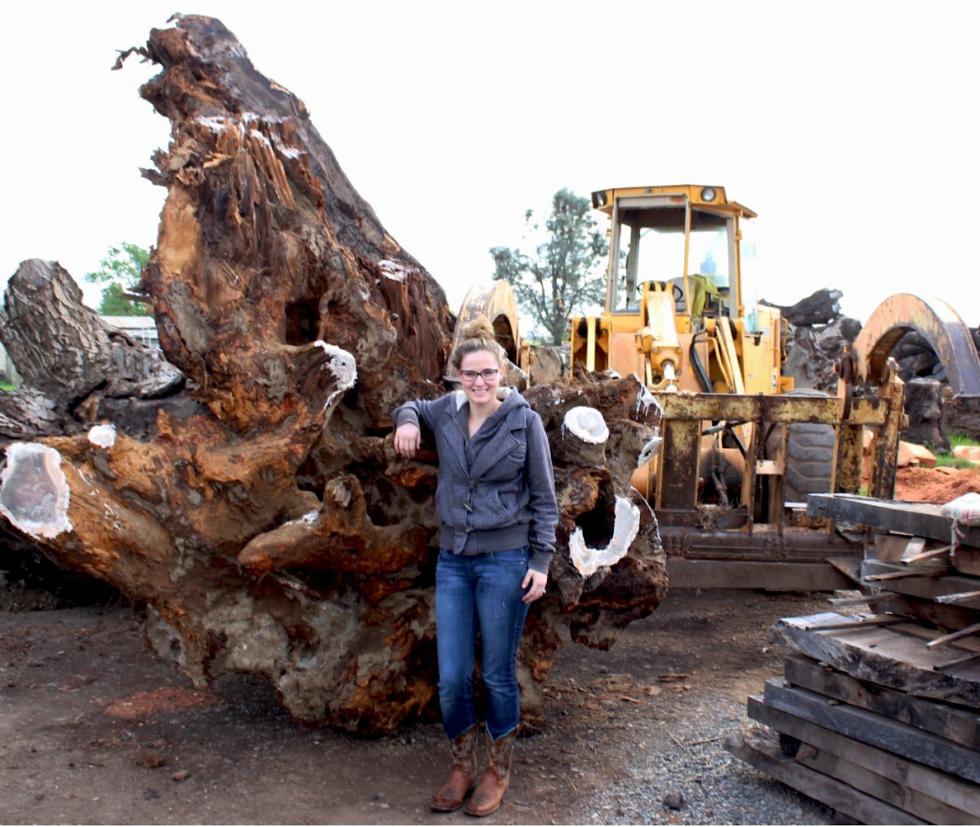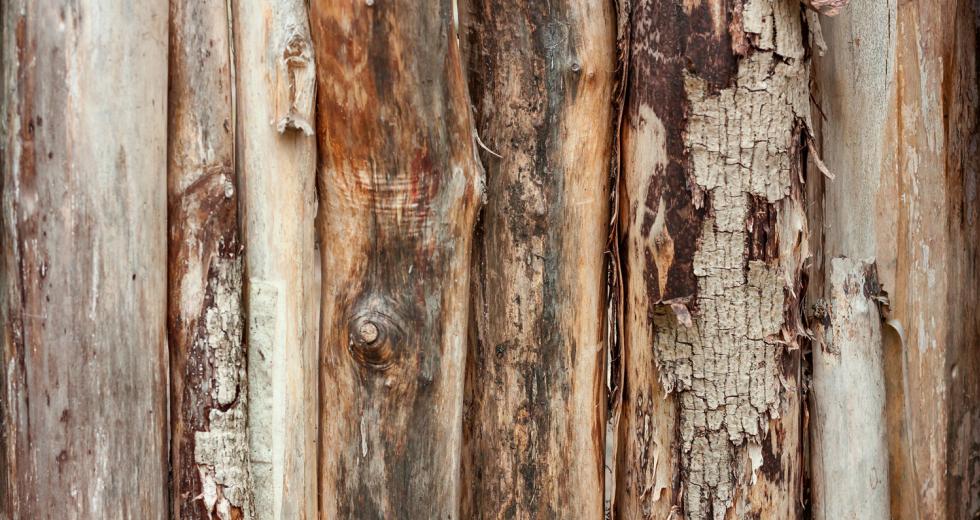The end of an urban tree’s life is a big deal. Here’s why.
Urban trees and salvaged lumber removed due to death, disease, damage or construction are typically burned, chipped or disposed of in landfills. We’re throwing away viable lumber: 3.8 billion board feet that could be generated annually from these trees, according to the U.S. Forest Service. That’s equivalent to 30 percent of the hardwood lumber commercially harvested in U.S. forests.
In response, an urban wood movement is growing across the country to reclaim this substantially-untapped natural resource, and efforts are booming in the Sacramento region.
Far West Forest Owner Jim Evans stands next to a slab of sugar
pine. (Photos courtesy Far West Forest Products)

Jennifer Alger, of Far West Forest Products, a family-owned and operated corporation specializing in urban, salvaged and reclaimed wood in Sheridan, in Placer County, is leading the cause on the West Coast. The company mills and dries the wood they receive, to sell in their retail store. Clients include homeowners, architects, designers and artists, contractors, cabinet and furniture makers, and small businesses.
Urban trees are those on all public and private land within our community. They’re managed by local municipalities and removed when they pose a safety concern, are in poor health, need to be cleared for construction or fall in a storm. Salvaged timber is any wood that is used for lumber once it has been removed. The common denominator: The wood was not cut down and removed for its timber value, Alger says.
Alger is a founding member and director of the newly 501(c)(3) nonprofit organization Urban, Salvaged and Reclaimed Woods, Inc., which focuses on educating the public about opportunities to use urban wood, and formalizing a membership of government agencies, companies and individuals involved with tree rescue, Alger explains.
“When a tree comes to the end of its natural life, it has another life as lumber that can be used at its highest purpose, beauty and longevity,” Alger says. Urban and salvaged wood isn’t always qualified to be used to construct homes, but this wood can be used in place of commercial lumber to build furniture, countertops, flooring, cabinets, tables, seating, framing, molding, paneling, sheds, functional and aesthetic art, play structures, fences … you name it.
Building a Market
But there are challenges to building a sustainable urban wood market, explains City of Sacramento Urban Forester Kevin Hocker. In commercial lumber operations, everything is geared toward the end product. In an urban forest, it’s hard to establish what will be removed or what will be available to use, Hocker says. This makes it difficult to plan for an end product and secure a market.
Olive wood. (Photos courtesy Far West Forest Products)

The Sacramento Tree Foundation must overcome this challenge. In fall 2016, the organization launched its Urban Wood Rescue program in partnership with the City of Sacramento and West Coast Arborists, a tree care company contracted by the City to remove and dispose of urban trees. The program is funded by a greenhouse gas recovery grant from the California Air Resources Board and Cal Fire, and is designed to divert logs from landfills and firewood to usable products that retain carbon, says Ray Tretheway, the foundation’s executive director.
When a tree decomposes, say, in a landfill, it releases carbon dioxide back into the atmosphere, contributing to climate change. Additionally, discarded logs waste limited landfill space, though many states now regulate landfill waste, including California.
Related: Tree maintenance is a must for property owners
Kiefer Landfill in Sacramento complements efforts by diverting logs for recycling, firewood or biomass fuel, which could be an opportunity for the Sacramento Tree Foundation to secure needed wood. If the organization can arrange transportation from Kiefer, Sacramento County could explore participating in its program, says Brenda Bongiorno, communication and media officer for Sacramento County.
Presently, the Sacramento Tree Foundation receives most of its wood from the City of Sacramento and West Coast Arborists as they remove urban trees in our community. Homeowners can donate downed trees as well, as long as the trees meet species, size and condition specifications. Additionally, the tree must be removed by an arborist who knows how to properly cut the tree for its future end product.
While the foundation’s grant is environmentally driven, the nonprofit organization is equally focused on return on community, which values engaging businesses and community members in identifying gaps in the local market and using available resources to fill them. It’s the essence of innovative business development.
That’s what Alger’s network does. By building a community of people who drive the market, someone will be interested in the wood that’s available at any particular time, she says. With a large enough network, people can swap and pool wood resources to have sufficient quantities of various woods to create sustainable markets.
Alyssa Aguayo, granddaughter of Jim Evans, stands in front of a
bastogne walnut log. (Photos courtesy Far West Forest
Products)

Alger’s goal is to establish the nonprofit as a go-to brand that identifies the wood as urban, salvaged or reclaimed. Members of the network — arborists, tree services, local governments, energy companies and sawyers who supply and deliver wood to companies like Far West Forest Products — can use the brand’s logo as marketing power and education.
Architectural firms, flooring companies, furniture and cabinet makers, as well as contractors, designers, artisans, wood turners and lumber companies can join too, and promote the local wood in their custom designs, benefiting from the brand’s recognition and online presence, Alger says.
Artisans Embrace Salvaged Wood
Word is catching on. Sacramento firm Dreyfuss + Blackford Architecture reached out to the Sacramento Tree Foundation to explore opportunities to use lumber from trees removed from Sacramento State to build the new welcome center. The goal is to incorporate the lumber back into the center’s design rather than waste the trees, explains Jenny Li, a project manager with the firm.
B Street Theatre is discussing opportunities to use salvaged urban wood inside the theater’s new location for aesthetics and acoustics. Uptown Studios, a Sacramento marketing and design company, plays on a ping-pong table made from urban wood purchased from Far West Forest Products. Even the giant Netflix purchased urban white oak slabs from Far West Forest Products for its corporate cafeteria.
There’s a rich market for the local artisan community, as well. Crafters often receive small pieces of wood that can’t be milled into lumber at no cost. Sacramento artist Trent Dean has a new line of seating made from urban wood that will be carried by the furniture store, West Elm. Marc Foster recently displayed one of his latest works, Repose, at Beatnik Studios, featuring a breathtaking root system of an urban tree uprooted during recent floods.
Proponents say there’s room for every business, community member and homeowner to ask: What am I using now that urban wood can replace? And perhaps make it even more beautiful and environmentally sound.



